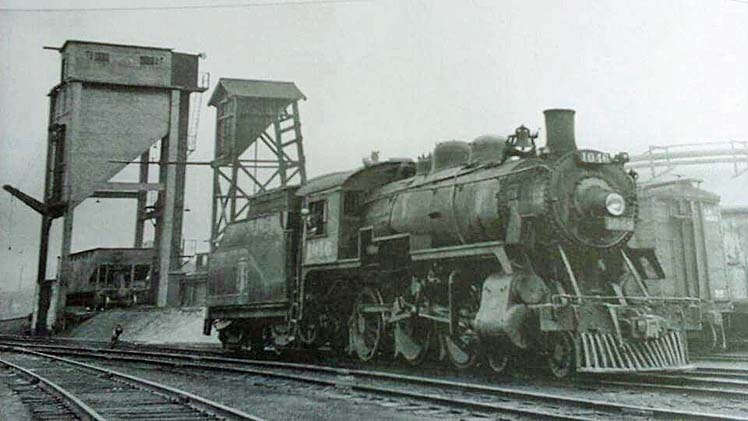
George Acker's Railway Days
Kentville Nova Scotia - The old rail bed is now a walking trail, and here and there, you'll find on it trestle bridges plus the odd signal
post the railway forgot to remove.
Except for a handful of historical books and collections of old photographs taken by the likes of A.L. Hardy and his contemporaries, little else remain of the
railway.
Of course, a few of the old railway hands are still here, and many people who rode the trains remember the railway's heyday, when the Valley thundered to the
shunting of steam locomotives.
Then there's what is remembered by those railway crews who still dwell among us.
One is George Acker, who was born in Granville Ferry in 1931 and now resides in Kentville.
Acker's father was a railway man in Annapolis.
"He was what was called an engine watchman," Acker says.
"One of his jobs was shoveling coal by hand into the tenders of the locomotives."
Acker began to work on the railway when he was 13.
At the time, the railway was hiring people as young as 15 (apparently this was the policy), but as George tells it, he was able to get around
this.
"I used to go up where Dad was working and help him. When word came down that they needed extra hands and were putting extra work gangs on, my father
suggested to the foreman, Clarence Haystead, that they hire me since I was already there doing the work.
"Haystead asked about my age. When Dad told him I was 13, Haystead said, well, he's big enough for 15, he's hired. So there I was, getting paid for
shovelling coal at 13-years-old."
Acker worked part-time at first.
A few years later, he went full time as a fireman and held this job for over 14 years.
Later, when diesels began replacing steam locomotives, many of the railway trades were eliminated.
Firemen were soon gone, since there was no longer any need to stoke locomotive engines with coal.
George Acker was one of the victims of this changing technology.
"I hoped to work on the railway all my life," Acker says, "but it didn't work out. I was phased out."
After the railway made his job obsolete, Acker tried his hand at several vocations, eventually settling in Kentville in 1960, where he worked at the Nova
Scotia Liquor Commission until he retired.
I recently met Acker at the Kings County Museum and when I heard about his time at the railway, I asked if I could interview him.
This resulted in a series of questions that he answered about the railway as it was in the early 1950s.
Q. What do you remember most about your days on the railway?
A. With me, it was the old steam engines. They were alive, you know, they were just like a part of you. That's what they felt like to me. I guess it's the
reason I enjoyed it so much on there.
Q. Were you there when the diesels came in or just after?
A. I was there when the diesels replaced the steam engines. They really changed things. I was working every day for years. After the diesels came, I had one
weeks work in a year. That ended my railroading career.
Q. Did you work on the locomotives?
A. Yes, I was a fireman.
Q. Lots of people would say they know what a fireman is, they ride on a big red truck. But what did a fireman do on the railway?
A. You had to keep the steam up for locomotive to run. You had to coal them to make the fire hot and you had to make sure there was enough water in the boiler
so it wouldn't go down and burn the crown sheet. So it was your responsibility (as a fireman) more or less to keep the steam up so the engine would
go.
Q. Did that mean you had to shovel a lot of coal?
A. Oh yes, that was your big job, shovelling coal. When you were going on a run, you had to make sure when you left the terminal that you had enough coal on
the tender and you checked the water to make sure there was enough. All you really needed was coal and water. You heat the water to make steam and that's what
drove'em. That's why they called them steam engines, I guess.(Laughing).
Q. Where were your runs normally?
A. I was everywhere. The longest run I had was on the way freight from Annapolis to Yarmouth. No one else from Kentville wanted to go down there and at the
time, I lived in Annapolis. When I couldn't get that run, I went to Kentville and went on the extra board. That meant I was on everything. To Truro, I'd go to
Halifax, over on the CVR (Cornwallis Valley Railway) and down to Weston. Work in the yard. Whatever they called me for I'd have to go do. We used to run the
CVR in the morning as a school train, to take the kids to KCA (Kings County Academy). Then we'd take them back at night. (Acker recalled that when the CVR was
discontinued, for a while the railway ran a bus for school kids driven by Starr Williams).
Q. Who do you remember most from your railway days, some of the oldtimers?
A. I worked with many of them. Bill Lockhart was on there. Tommy Walsh, Harry Trask. I have a seniority list of them. Jack Bishop worked in the shops. Bob
Bishop worked in the roundhouse. Gordon Redden was pretty big in the machine shop. They used to rebuild those old locomotives in the machine shop. Tear them
apart and put them back together. Jake Corbin was another one there in the machine shop. He was a first-class mechanic. Clarence Haystead was the
roadmaster.
Acker recalled that when he visited the graveyard to "see his wife," he often would go around and stop at the grave sites of some of the railway men
and reminisce about his railway days.
One of those is about a prank that had the railway gangs laughing for days.
"I can recall one time here, Bill Simmons (I can ramble on and on and on here) he was the conductor on the way freight train to Annapolis, and Doug Jolly
and Roy Murray were the two brakemen, one in the front, one in the rear. So Bill Simmons, he got hot in the caboose and he got after the car shop and said,
can't you build me a screen door that I can put on the caboose. It's some warm in there. After a while, the shop came up with a screen door. Bill picked it up,
went to put it up in the caboose and it was too long. Bill measured it up and marked where he could cut it, laid it on two chairs and went over to the
carpenter shop to get a saw. When he was gone, Roy Murray and Doug Jolly turned the screen over and put a different mark on it. Bill came back and sawed it off
and it was too short."
Ed Coleman.
provisions in Section 29 of the Canadian
Copyright Modernization Act.

